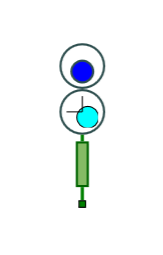I understand that we can construct node templates vertically or horizontally. But what if need, for example, to draw cross in the middle of top circle?
The code is following:
var custom2Template =
$(go.Node, "Vertical", nodeStyle(),
$(go.Shape, "Circle", shapeStyle1(),
{ fill: white }),
$(go.Shape, "Circle", shapeStyle1(),
{ fill: red, width: 20, height: 20 }),
$(go.Shape, "Rectangle", shapeStyle4(),
{ fill: green }),
$(go.Shape, "Rectangle", shapeStyle3(),
{ fill: dollarbill },
{ visible: true }),
$(go.Shape, "Rectangle", shapeStyle5(),
{ fill: green }),
$(go.Shape, "Rectangle", portStyle1(true),
{ portId: "" }),
$(go.Shape, "Rectangle", portStyle2(true),
{ portId: "" }),
});